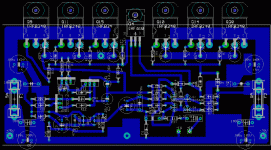hi
i've build the n-channel amp from www.aussieamps...... with my own pcb. It works great. B]But is it true, that the heatsink temperatur is without load 50-60 degrees??[/B]
i've not matched the mosfets, so is this the problem?
thx a lot
i've build the n-channel amp from www.aussieamps...... with my own pcb. It works great. B]But is it true, that the heatsink temperatur is without load 50-60 degrees??[/B]
i've not matched the mosfets, so is this the problem?
thx a lot
Re:
I have no exact temp. measurement yet, but I do not think mine is more than ~ 40º C, when bias is set as instructed.
(BTW, do you have spare PCB's?)
Arne K
I have no exact temp. measurement yet, but I do not think mine is more than ~ 40º C, when bias is set as instructed.
(BTW, do you have spare PCB's?)
Arne K
PCBs
the pcbs are selfmade.
tomorrow i can post a pic. or if you want a .brd file.
i check bias tomorrow too.
thx
the pcbs are selfmade.
tomorrow i can post a pic. or if you want a .brd file.
i check bias tomorrow too.
thx
The idol dissipation of this amp is 42watts. Most class A\B amps would consider that high, however this amp is not really biased that high (300mA), it’s just that the rails use a high voltage +-70v. It would be a good idea to see what effect changing the bias has on the sound.
The heat sink temp is what ever your heat sinks say it is. The Bigger the heat sink the lower the temp. To find out what the idol dissipation temp is just take 42 and multiply it by the thermal coefficient of the heat sink. The amp will dissipate more when it’s playing music. If you think something is wrong with the bias just keep an eye on the .33ohm resistors. If there is more the .033V across it then you bias is off.
How do you think this amp sounds? Could you compare this amp to something else?
We’re all waiting for pics.
The heat sink temp is what ever your heat sinks say it is. The Bigger the heat sink the lower the temp. To find out what the idol dissipation temp is just take 42 and multiply it by the thermal coefficient of the heat sink. The amp will dissipate more when it’s playing music. If you think something is wrong with the bias just keep an eye on the .33ohm resistors. If there is more the .033V across it then you bias is off.
How do you think this amp sounds? Could you compare this amp to something else?
We’re all waiting for pics.
here is my pcb
here is my own pcb.
i've made it with eagle.
it works great, but keep a look at Q1, Q16 and Q13.
there was some trouble with them because of a false pinout in my pcb. i've corrected this, but still keep a look.
i'm creating currently some new pcb with a protection circuit witch is a little smaller. hear from me later.
feel free to ask.
best regards
ps: betterquality pics on inquires
here is my own pcb.
i've made it with eagle.
it works great, but keep a look at Q1, Q16 and Q13.
there was some trouble with them because of a false pinout in my pcb. i've corrected this, but still keep a look.
i'm creating currently some new pcb with a protection circuit witch is a little smaller. hear from me later.
feel free to ask.
best regards
ps: betterquality pics on inquires
Attachments
Re:
Hi!
If you do a re-design, you could moove the bias-compensating transistor....so it is closer to the output devices, (it will probably need extension-leads anyway to reach ontop?).
See: http://www.diyaudio.com/forums/showthread.php?postid=80663#post80663
Arne K
Hi!
If you do a re-design, you could moove the bias-compensating transistor....so it is closer to the output devices, (it will probably need extension-leads anyway to reach ontop?).
See: http://www.diyaudio.com/forums/showthread.php?postid=80663#post80663
Arne K
- Status
- Not open for further replies.
- Home
- Amplifiers
- Solid State
- n channel amp temperatur
